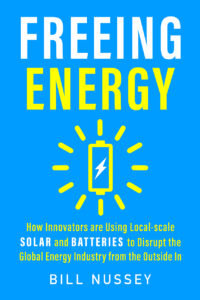This article is the fifth in our series on nuclear power. The first article covers the economics of nuclear power. The second looks at the dangers of nuclear accidents, the third examines the health impacts of radiation, and the fourth explores the issues of nuclear waste.
When we think about electricity and the grid, national security is not necessarily the first topic that comes to mind. While a stable grid is essential for the well being of developed countries, nuclear power magnifies the risks and rewards of making electricity to a level of national security. Few types of power generation are more contentious and none have the potential to affect the well being of nations like nuclear power – as both defender and demolisher.
Benefit: the moral standing of reduced greenhouse gas emissions
If you need large, steady volumes of greenhouse-gas-free electricity, nuclear is your “go to” option. While the current US administration isn’t prioritizing the reduction of emissions, it’s likely that increasing public concern will drive future administrations and legislatures to embrace American’s unique position at the world’s largest generator of emission-free nuclear power.
Benefit: A bigger pool of nuclear scientists helps the US maintain its nuclear weapons arsenal
To the making of these fateful decisions, the United States pledges before you—and therefore before the world its determination to help solve the fearful atomic dilemma—to devote its entire heart and mind to find the way by which the miraculous inventiveness of man shall not be dedicated to his death, but consecrated to his life.
— President Dwight D. Eisenhower, New York City, December 8, 1953
In an effort to mitigate the public’s growing concern over global nuclear warfare, President Eisenhower kicked off a national effort to promote peaceful uses of “atomic” power. In his 1953 speech, he coined the term “atoms for peace.” A year later, the US passed the Atomic Energy Act which laid the groundwork for the civilian applications of nuclear energy. The primary benefit was the creation of a domestic nuclear-powered electricity industry.

One of the subtle benefits of Eisenhower’s peaceful nuclear vision was greatly enlarging the pool of engineers and scientists with nuclear expertise. The continuing research into nuclear power indirectly helps the US maintain a credible position as the pioneers of all things nuclear. Everyone in the world hopes that this approach will continue deterring nuclear weapons proliferation and outright warfare.
A hot debate: nuclear plants enable a more resilient grid because they can stockpile fuel
The US administration has recently argued that nuclear power is essential for US national security (here, here, and here). They claim that the ability to stockpile fuel near nuclear (and coal power) plants makes them the most resilient sources of electricity in the face of a national emergency that might threaten fuel supply chains. Since each batch of fuel powers a plant for 18 months, nuclear reactors can operate far longer than any other fuel-based power plant — even without stockpiles.
While this argument makes sense at some level, the federal agency overseeing the US grid dismissed the US administration’s argument and countered that fuel supply is almost never a source of outages.
GET MONTHLY NEWS & ANALYSIS
Unsubscribe anytime. We will never sell your email or spam you.
Concern: nearly all the nuclear fuel used by US plants comes from outside the country

The US Commerce Department recently began investigating an awkward reality of nuclear power – nearly all the nuclear fuel used in US power plants is imported from other countries. As the US nuclear industry has stagnated and uranium prices have dropped, the nuclear fuel supply chain has mostly shifted outside the US. According to the US Energy Information Administration, the US only mines 11% of the uranium it consumes. Foreign supplies include 24% from Kazakhstan and 14% from Russia.
Additionally, the US only has the capacity to enrich one-third of its raw uranium. By comparison, fuel for natural gas and coal plants are sourced entirely within the US. And electricity from solar and wind requires no ongoing supply chain at all. Of course, if nuclear power became a growth industry again, much of the more expensive domestic production could be revitalized again, rebalancing the nuclear supply chain.
Concern: Nuclear power plants are an obvious target during warfare
While nuclear fuel stockpiles have recently been associated with increased national security, nuclear plants have a longer history as being uniquely vulnerable during warfare. Most plants are designed to withstand the direct impact of an airline crash, but few could survive a direct hit from a cruise missile fired 1,000 miles offshore (almost a dozen countries possess cruise missiles). My earlier research found the radiation from a destroyed nuclear reactor might not lead to any large scale loss of life, but the resulting public panic could be devastating.
Concern: Terrorism and nuclear power plants
In the early part of 2009, the operators of a secret Iranian nuclear fuel processing facility discovered something completely inexplicable. Despite being underground and “air-gapped” with no digital connections to the outside world, nearly 1,000 nuclear centrifuges had been destroyed. Only later did the Iranians, and the rest of the world, realize the culprit was a computer virus of unprecedented sophistication called Stuxnet.

Threats of terrorism are magnified when nuclear fuel and radioactive waste are involved. Exploding a bomb near a spent fuel containment pool could release a radioactive cloud. Stolen uranium or plutonium can power a dirty bomb capable of rendering a city uninhabitable. But cyberterrorism is perhaps the most chilling of all because the hackers can attack the plant from anywhere on earth. In 2008, you would have been hard-pressed to find a single computer expert that would believe a virus like Stuxnet could succeed. Today, most experts would be unwilling to place limits on the destructive potential of computer viruses. Cyberterrorism is an ever-escalating battle with each side taking turns outsmarting the other. While it is correct to say that a successful cyber attack on a nuclear power plant is unlikely, it would be dangerously naive to say it is impossible.
The Freeing Energy Perspective
Nuclear power, and more broadly, the grid, are important components of US national security. Global fuel supply chains, the co-mingling of expertise with weapons programs, and threats from terrorism are all factors that affect the welfare of the US. But my research into this topic uncovered another angle that is rarely mentioned and may be the most important of all.
On April 14, 2006, Mikhail Gorbachev, the eighth and final leader of the USSR, authored a reflection on the fall of the Soviet Union,
The nuclear meltdown at Chernobyl 20 years ago this month, even more than my launch of perestroika [restructuring], was perhaps the real cause of the collapse of the Soviet Union five years later. Indeed, the Chernobyl catastrophe was an historic turning point: there was the era before the disaster, and there is the very different era that has followed.
Gorbachev’s powerful statement drives home the deeper risks of nuclear power. While nuclear accidents are rare and Chernobyl may be the worst we ever see, nuclear power can not only impact national security; it can determine the fate of nations.




One Response
Good and balanced review of the possibilities … Liked it.